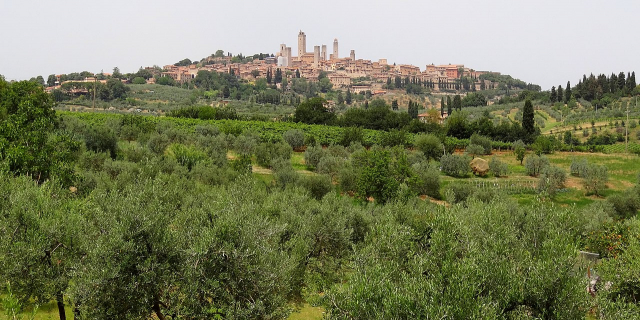Campanile di Giotto
( Giotto's Campanile )Giotto's Campanile (, also US: , Italian: [kampaˈniːle]) is a free-standing campanile that is part of the complex of buildings that make up Florence Cathedral on the Piazza del Duomo in Florence, Italy.
Standing adjacent to the Basilica of Santa Maria del Fiore and the Baptistry of St. John, the tower is one of the showpieces of Florentine Gothic architecture with its design by Giotto, its rich sculptural decorations and its polychrome marble encrustations.
The slender structure is square in plan with 14.45 metre (47.41 ft) sides. It is 84.7 metres (277.9 ft) tall and has polygonal buttresses at each corner. The tower is divided horizontally into five stages.
 View of the bell tower from the east
View of the bell tower from the east Lozenges of north side.
Lozenges of north side. Original hexagonal panel depicting jurisprudence.
Original hexagonal panel depicting jurisprudence. The lower levels with the hexagonal panels, lozenges and statues.
The lower levels with the hexagonal panels, lozenges and statues.On the death of Arnolfo di Cambio in 1302, the first Master of the Works of the Cathedral, and after an interruption of more than thirty years, the celebrated painter Giotto di Bondone was nominated as his successor in 1334.[1] At that time he was 67 years old. Giotto concentrated his energy on the design and construction of a campanile (bell tower) for the cathedral. He had become an eminent architect, thanks to the growing autonomy of the architect-designer in relation to the craftsmen since the first half of the 13th century. The first stone was laid on 19 July 1334.[2] His design was in harmony with the polychromy of the cathedral, as applied by Arnolfo di Cambio, giving the tower a view as if it were painted. In his design, he also applied chiaroscuro and some form of perspective instead of a strict linear drawing of the campanile. And instead of a filigree skeleton of a gothic building, he applied a surface of coloured marble in geometric patterns.
When he died in 1337, he had only finished the lower floor with its marble external revetment: geometric patterns of white marble from Carrara, green marble from Prato and red marble from Siena. This lower floor is decorated on three sides with bas-reliefs in hexagonal panels, seven on each side. When the entrance door was enlarged in 1348, two panels were moved to the empty northern side and only much later, five more panels were commissioned from Luca della Robbia in 1437. The number "seven" has a special meaning in Biblical sense: it symbolizes human perfectibility.
It is difficult to attribute artistic paternity to these panels. Some may be by Giotto himself, the others by Andrea Pisano (or their workshops).
Through this work, Giotto has become, together with Brunelleschi (dome of the cathedral of Florence) and Alberti (with his treatise De re aedificatoria, 1450), one of the founding fathers of Italian Renaissance architecture.
Giotto was succeeded as Master of the Works in 1343 by Andrea Pisano,[1] famous already for the South Doors of the Baptistery. He continued the construction of the bell tower, scrupulously following Giotto's design. He added, above the lower level of Giotto, a second fascia, this time decorated with lozenge-shaped panels (1347–1341).[dubious ] He built two more levels, with four niches on each side and each level, but the second row of niches are empty. Construction came to a halt in 1348, year of the disastrous Black Death.
Pisano was replaced in his turn by Francesco Talenti who built the top three levels, with the large windows, completing the bell tower in 1359.[1] He did not build the spire designed by Giotto, thus lowering the designed height of 122 metres (400 ft) to 84.7 metres (277.9 ft). The top, with its scenic panorama of Florence and the surrounding hills, can be reached by climbing 414 steps.

































Add new comment